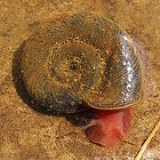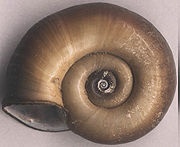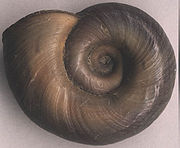
Planorbarius corneus
Encyclopedia
Planorbarius corneus, common name
the great ramshorn, is a relatively large species
of air-breathing freshwater snail
, an aquatic
pulmonate gastropod mollusk in the family
Planorbidae
, the ram's horn snails, or planorbids, which all have sinistral or left-coiling shells.
The shell of this species appears to be dextral in coiling, even though it is in fact sinistral or left-handed.
The native range of this pond snail is from Europe
to central Asia
.
This large planorbid is found in water which is still, or only moving slowly, where there is a good growth of many different kinds of pond weeds, and where there are high levels of calcium dissolved in the water.
Planorbarius corneus under high temperatures has been studied by Kartavykh & Podkovkin (2002).
This species of snail functions as a host for several parasite species:
Common name
A common name of a taxon or organism is a name in general use within a community; it is often contrasted with the scientific name for the same organism...
the great ramshorn, is a relatively large species
Species
In biology, a species is one of the basic units of biological classification and a taxonomic rank. A species is often defined as a group of organisms capable of interbreeding and producing fertile offspring. While in many cases this definition is adequate, more precise or differing measures are...
of air-breathing freshwater snail
Freshwater snail
A freshwater snail is one kind of freshwater mollusc, the other kind being freshwater clams and mussels, i.e. freshwater bivalves. Specifically a freshwater snail is a gastropod that lives in a watery non-marine habitat. The majority of freshwater gastropods have a shell, with very few exceptions....
, an aquatic
Aquatic animal
An aquatic animal is an animal, either vertebrate or invertebrate, which lives in water for most or all of its life. It may breathe air or extract its oxygen from that dissolved in water through specialised organs called gills, or directly through its skin. Natural environments and the animals that...
pulmonate gastropod mollusk in the family
Family (biology)
In biological classification, family is* a taxonomic rank. Other well-known ranks are life, domain, kingdom, phylum, class, order, genus, and species, with family fitting between order and genus. As for the other well-known ranks, there is the option of an immediately lower rank, indicated by the...
Planorbidae
Planorbidae
Planorbidae, common name the ramshorn snails or ram's horn snails, is a family of air-breathing freshwater snails, aquatic pulmonate gastropod mollusks....
, the ram's horn snails, or planorbids, which all have sinistral or left-coiling shells.
The shell of this species appears to be dextral in coiling, even though it is in fact sinistral or left-handed.
Distribution
The native range of this pond snail is from Europe
Europe
Europe is, by convention, one of the world's seven continents. Comprising the westernmost peninsula of Eurasia, Europe is generally 'divided' from Asia to its east by the watershed divides of the Ural and Caucasus Mountains, the Ural River, the Caspian and Black Seas, and the waterways connecting...
to central Asia
Asia
Asia is the world's largest and most populous continent, located primarily in the eastern and northern hemispheres. It covers 8.7% of the Earth's total surface area and with approximately 3.879 billion people, it hosts 60% of the world's current human population...
.
- Not listed in IUCN red listIUCN Red ListThe IUCN Red List of Threatened Species , founded in 1963, is the world's most comprehensive inventory of the global conservation status of biological species. The International Union for Conservation of Nature is the world's main authority on the conservation status of species...
– not evaluated (NE) - Czech Republic – least concern (LC)
- Germany
- Netherlands
- Russia – Sverdlovsk oblastSverdlovsk OblastSverdlovsk Oblast is a federal subject of Russia located in the Urals Federal District. Its administrative center is the city of Yekaterinburg formerly known as Sverdlovsk. Population: -Geography:...
- Slovakia
- Poland
- British Isles: Great Britain, Ireland
- Slovenia
Description
All species within family Planorbidae have sinistral shells. |
 |
Habitat
This large planorbid is found in water which is still, or only moving slowly, where there is a good growth of many different kinds of pond weeds, and where there are high levels of calcium dissolved in the water.
Planorbarius corneus under high temperatures has been studied by Kartavykh & Podkovkin (2002).
Parasites
This species of snail functions as a host for several parasite species:
- as first intermediate hostIntermediate hostA secondary host or intermediate host is a host that harbors the parasite only for a short transition period, during which some developmental stage is completed. For trypanosomes, the cause of sleeping sickness, humans are the primary host, while the tsetse fly is the secondary host...
for Prosthogonimus ovatus - as first intermediate hostIntermediate hostA secondary host or intermediate host is a host that harbors the parasite only for a short transition period, during which some developmental stage is completed. For trypanosomes, the cause of sleeping sickness, humans are the primary host, while the tsetse fly is the secondary host...
for Apatemon gracilis - as first and as second intermediate host for Hypoderaeum conoideumHypoderaeum conoideumHypoderaeum conoideum is a species of digenetic trematode in the family Echinostomatidae.The known first intermediate host of Hypoderaeum conoideum include freshwater snails Planorbarius corneus, Indoplanorbis exustus, Lymnaea stagnalis, Lymnaea limosa, Radix ovata and Radix...
- as intermediate host for Syngamus trachea
- as intermediate host for Typhlocoelum sisowi

